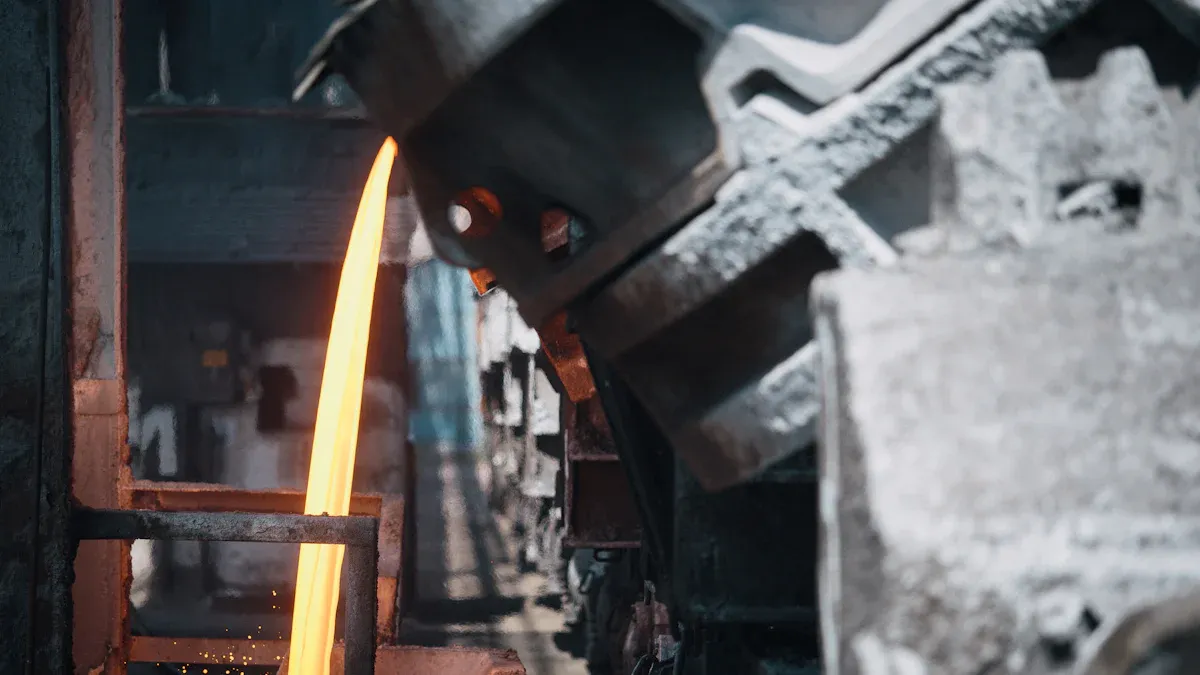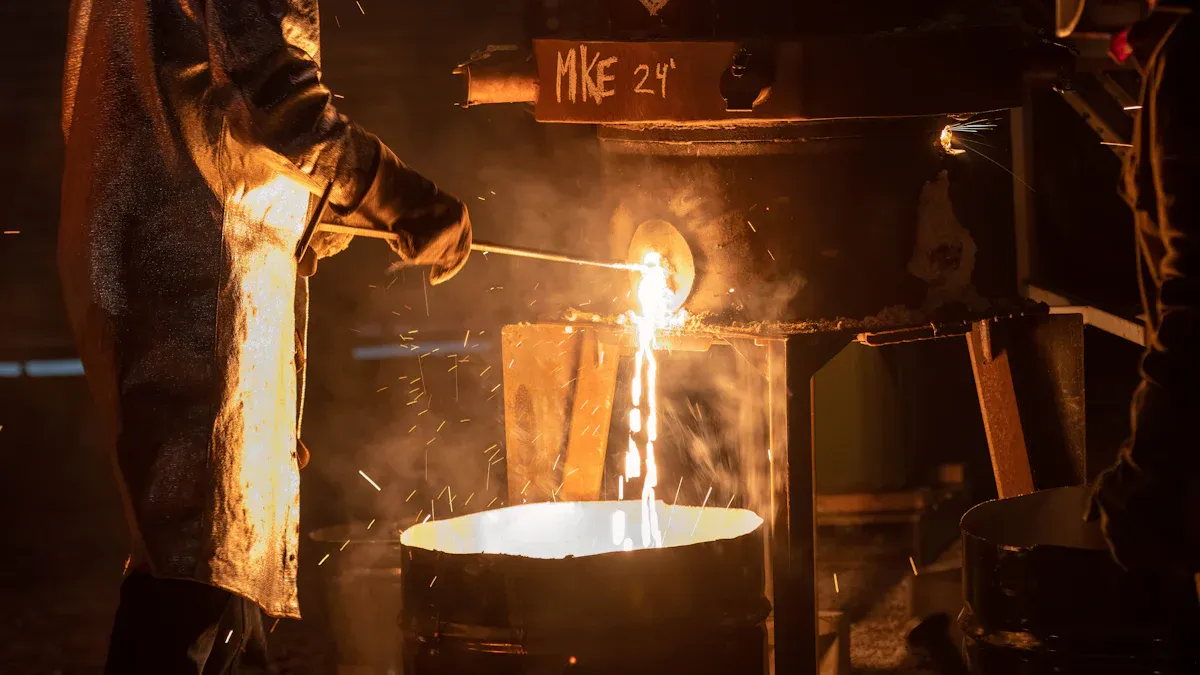
Lost wax casting stands out as the perfect method for creating OEM precision lost wax casting stainless steel flanges. This process ensures unmatched precision and durability, making it ideal for industrial components. A lost wax casting stainless steel flange resists corrosion and maintains a smooth surface, which is crucial for industries like oil and gas. With OEM precision lost wax casting flanges, manufacturers can achieve intricate designs without compromising quality. The result? Reliable and cost-effective solutions for demanding applications, including OEM casting stainless steel flanges.
Key Takeaways
- Lost wax casting is very accurate, perfect for tricky designs in stainless steel flanges. This accuracy means fewer fixes are needed later.
- The method gives a smooth surface and resists rust, making it last longer in tough places like oil and gas. This helps avoid contamination and improves how it works.
- Lost wax casting saves money. It cuts down on machining time and wasted materials, saving costs while keeping great quality.
Advantages of OEM Precision Lost Wax Casting Stainless Steel Flange

High Dimensional Accuracy for Complex Designs
Lost wax casting excels in producing stainless steel flanges with intricate designs and tight tolerances. This method achieves high dimensional accuracy, which is critical for industries requiring precision components. For example, in industrial piping systems, even a slight deviation can lead to inefficiencies or safety risks. Lost wax casting ensures that every flange meets exact specifications, reducing the need for post-production adjustments.
To highlight its precision, consider the following comparison of casting methods:
| Casting Method | Dimensional Accuracy (CT) | Notes |
|---|---|---|
| Investment Casting | CT4-6 | Higher accuracy than sand mold (CT10-13) and die casting (CT5-7). |
| Sand Mold Casting | CT10-13 | Lower precision compared to investment casting. |
| Die Casting | CT5-7 | Moderate precision, less than investment casting. |
This table demonstrates why lost wax casting, also known as investment casting, is the preferred choice for achieving superior dimensional accuracy. Its ability to handle complex geometries makes it ideal for creating OEM Precision Lost Wax Casting Stainless Steel Flanges.
Superior Surface Finish and Corrosion Resistance
A smooth surface finish is more than just an aesthetic feature—it plays a vital role in the performance of stainless steel flanges. Lost wax casting delivers a superior surface finish, reducing the need for extensive machining or polishing. This process also enhances the flange’s resistance to corrosion, a key requirement for industries like oil and gas, where components are exposed to harsh environments.
The combination of advanced casting technologies and skilled craftsmanship ensures that each flange maintains its material integrity. Rigorous quality control further guarantees that the final product meets industry benchmarks. Here’s a quick overview of the factors contributing to the quality of lost wax cast flanges:
| Aspect | Description |
|---|---|
| Dimensional Accuracy | High precision is crucial for producing quality components across various industries. |
| Surface Finish | Advanced technologies and skilled labor contribute to superior surface quality. |
| Material Integrity | Rigorous quality control ensures the integrity of materials used in casting. |
| Cost Efficiency | Specialized factories optimize processes to enhance cost-effectiveness while maintaining precision. |
| Customization | The ability to customize components according to specific industry needs is a significant advantage. |
This level of quality makes OEM Precision Lost Wax Casting Stainless Steel Flanges a reliable choice for demanding applications.
Cost Efficiency Through Reduced Machining
Lost wax casting minimizes the need for extensive machining, which translates to significant cost savings. The process creates near-net-shape components, meaning the flanges require little to no additional work to meet specifications. This efficiency not only reduces material waste but also shortens production times.
To illustrate the cost benefits, consider the following comparison:
| Factor | Lost Wax Casting | CNC Machining |
|---|---|---|
| Machining Time | Reduced | Higher |
| Material Waste | Minimal | Significant |
By reducing machining time and material waste, manufacturers can lower production costs without compromising quality. This makes lost wax casting an economical choice for producing OEM Precision Lost Wax Casting Stainless Steel Flanges.
Lost Wax Casting vs. Other Methods
Sand Casting vs. Lost Wax Casting
Sand casting is often chosen for its simplicity and low upfront costs, but it falls short in precision and surface quality. This method uses sand molds, which can’t achieve the same level of detail as lost wax casting. Sand casting typically results in rough surfaces and requires extensive machining to meet dimensional specifications.
Lost wax casting, on the other hand, excels in producing complex shapes with tight tolerances. It delivers exceptional surface finishes, reducing the need for post-production work. Additionally, the energy efficiency of lost wax casting is noteworthy:
- Energy required for lost wax casting: 12.124 kWh
- Energy required for CNC machining: 17.297 kWh
- Cost per gram for lost wax casting: $0.067
- Cost per gram for CNC machining: $0.096
These metrics highlight the cost and energy savings of lost wax casting compared to sand casting. For manufacturers seeking high-quality OEM Precision Lost Wax Casting Stainless Steel Flanges, lost wax casting offers a more efficient and economical solution.
Investment Casting vs. Lost Wax Casting
Investment casting and lost wax casting are often used interchangeably, as both involve creating patterns from wax. However, subtle differences exist in the materials and processes used. Studies show that investment casting with wax-based patterns yields superior hardness compared to ABS-based patterns. This indicates that lost wax casting, a subset of investment casting, can deliver better mechanical properties under specific conditions.
Lost wax casting also stands out for its ability to produce intricate designs with minimal material waste. While investment casting shares many of these benefits, lost wax casting’s focus on precision and surface quality makes it the preferred choice for stainless steel flanges. Manufacturers rely on this method to create components that meet rigorous industrial standards without compromising durability or performance.
Why Lost Wax Casting Is the Superior Choice
Lost wax casting outshines other methods in several key areas:
- Ability to produce complex shapes
- Exceptional surface quality
- Rigorous quality control measures
These advantages make it the go-to method for producing OEM Precision Lost Wax Casting Stainless Steel Flanges. Its ability to handle intricate designs ensures that manufacturers can meet the demands of industries like oil and gas, chemical processing, and energy. The process also minimizes machining and material waste, resulting in cost-effective production without sacrificing quality.
For industries requiring reliable and durable components, lost wax casting delivers unmatched performance. Its combination of precision, efficiency, and adaptability makes it the superior choice for stainless steel flange production.
Applications of Stainless Steel Flanges Produced with Lost Wax Casting

Industrial Piping and Valve Systems
Lost wax casting plays a vital role in manufacturing stainless steel flanges for industrial piping and valve systems. These systems demand components with extreme dimensional accuracy and consistent reliability. Lost wax casting delivers on both fronts, enabling manufacturers to create flanges with intricate designs that fit seamlessly into complex assemblies.
The ability to use high-performance alloys further enhances the suitability of this method for critical equipment. Stainless steel flanges produced through lost wax casting withstand high pressures and temperatures, making them ideal for demanding environments. Here’s a quick look at how this technology meets industry needs:
| Performance Aspect | Description |
|---|---|
| Accuracy | Enables complex designs with extreme dimensional accuracy, essential for critical equipment operation. |
| Material Selection | Supports high-performance alloys that withstand harsh conditions, ideal for critical components. |
| Reliability | Ensures consistent quality and performance, crucial for components in extreme environments. |
These qualities make lost wax casting the preferred choice for producing flanges used in industrial piping and valve systems.
Oil, Gas, and Energy Sector
The oil, gas, and energy industries rely on stainless steel flanges to maintain the integrity of their operations. Lost wax casting ensures these flanges meet stringent requirements for durability and corrosion resistance. Components in this sector often face exposure to harsh chemicals, high pressures, and fluctuating temperatures.
Lost wax casting allows manufacturers to create flanges that perform reliably under these conditions. The process minimizes material waste while delivering precision, ensuring that every flange meets industry standards. This combination of efficiency and quality makes lost wax casting indispensable for producing components used in pipelines, refineries, and power plants.
Chemical and Food Processing Equipment
Chemical and food processing industries prioritize hygiene and corrosion resistance in their equipment. Stainless steel flanges produced through lost wax casting excel in both areas. The smooth surface finish achieved by this method reduces the risk of contamination, making it ideal for applications where cleanliness is critical.
In chemical processing, flanges must resist corrosive substances while maintaining structural integrity. Lost wax casting supports the use of specialized alloys that meet these requirements. For food processing, the method ensures flanges are easy to clean and maintain, contributing to safer operations.
By combining precision, durability, and adaptability, lost wax casting provides the perfect solution for manufacturing stainless steel flanges used in chemical and food processing equipment.
Lost wax casting offers unmatched benefits for stainless steel flange production. Its precision ensures tight tolerances, while versatility supports a wide range of alloys. The process delivers smooth surface finishes, reducing machining and saving time.
| Benefit | Description |
|---|---|
| High Precision | Achieves tight tolerances and detailed geometries, ideal for components requiring accuracy. |
| Versatility | Suitable for a wide range of metals and alloys, allowing for optimal material selection. |
| Smooth Surface Finish | Produces parts with excellent surface quality, reducing the need for extensive machining. |
| Reduced Machining | Minimizes secondary machining operations, saving time and reducing material waste. |
| Design Flexibility | Allows for complex designs that meet specific performance requirements. |
These advantages make lost wax casting a smart choice for industries needing reliable, high-quality components. Manufacturers looking for efficiency and durability should explore this method for their next project.
FAQ
What makes lost wax casting better for stainless steel flanges?
Lost wax casting delivers precise designs, smooth surfaces, and reduced machining. These qualities make it ideal for industries needing durable and corrosion-resistant components.
Can lost wax casting handle custom designs?
Yes! Manufacturers can create intricate, custom designs with tight tolerances using lost wax casting. This flexibility suits industries with specific performance requirements.
Is lost wax casting cost-effective for large-scale production?
Absolutely. Lost wax casting minimizes material waste and machining time, reducing production costs while maintaining high-quality standards for stainless steel flanges.
